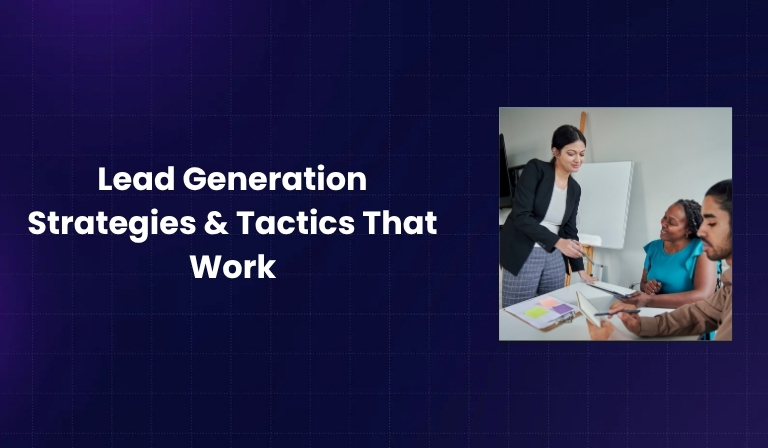Generating leads is one of the most important parts of growing a business. But with so many tactics out there, it can be hard to know what really works. In this guide, we’ll break down 11 proven lead generation strategies that you can start using today — plus a bonus framework to help you capture and convert leads more effectively.
What Is Lead Generation and Why It Matters
Lead generation is the process of attracting potential customers and getting their contact information so you can reach out to them later. It’s all about turning strangers into interested prospects — and eventually into paying customers.
Without leads, your business can’t grow. A strong lead generation strategy keeps your sales funnel full, builds awareness, and helps your brand stay top-of-mind with potential buyers.
11 Proven Lead Generation Strategies
1. Content Marketing
Content marketing is all about creating valuable content that answers your audience’s questions. This includes blog posts, eBooks, whitepapers, infographics, and more.
By providing helpful information, you can build trust and encourage users to give you their contact info — especially if you offer something useful in return, like a free guide or checklist.
Focus on SEO-optimized content that targets keywords your audience is actually searching for.
2. Search Engine Optimization (SEO)
SEO helps your content and website show up on search engines like Google. This increases your chances of getting discovered by people who are already looking for what you offer.
Use keyword research to find what your ideal customer is searching for, then optimize your pages with high-quality content, good meta tags, and fast load speeds.
Use tools like Ahrefs, Semrush, or Google Search Console to track performance and find new opportunities.
3. Website Optimization
Your website is often the first place potential leads visit — so make it count. Use clear CTAs (calls-to-action), fast load times, and a mobile-friendly design.
Optimized landing pages can dramatically increase conversions by focusing on one goal, such as getting a user to download an eBook or sign up for a demo.
Use A/B testing tools like Google Optimize or Optimizely to test different versions of your landing pages.
4. Email Marketing
Once someone gives you their email address, email marketing is a great way to stay in touch. Use welcome sequences, newsletters, and drip campaigns to nurture leads and guide them toward a purchase.
Segment your email list based on interests and behavior to deliver more personalized messages.
Tools like Mailchimp, ConvertKit, or ActiveCampaign make automation easy.
5. Pay-Per-Click (PPC) Advertising
PPC ads, like Google Ads or Bing Ads, can get your content in front of potential leads fast. You only pay when someone clicks, so it’s a great way to target specific keywords and demographics.
Make sure your ads lead to dedicated landing pages for better conversion rates.
Use negative keywords and geotargeting to improve your ad performance and reduce wasted spend.
6. Social Media Content Marketing
Posting valuable, engaging content on social media can organically attract leads. Share blog posts, tips, videos, and behind-the-scenes looks at your business.
Consistency and authenticity go a long way in building a loyal community who will eventually convert into leads.
Also Read: How Much Money Do You Get Per View on YouTube? [2025 Updated]
Use a content calendar to plan your posts and maintain regular activity.
7. Social Media Advertising
Platforms like Facebook, Instagram, and LinkedIn offer powerful ad targeting features. You can reach users based on interests, job titles, location, and even past behavior.
Use lead ads or conversion-optimized campaigns to collect contact info directly from social platforms.
Try using lookalike audiences to reach people similar to your existing customers.
8. Lead Magnets & Gated Content
Lead magnets are valuable resources you offer in exchange for a user’s contact information. Think free templates, guides, or checklists.
Place them behind a simple form on your landing page — just make sure what you’re offering solves a specific problem.
Keep forms short. Asking for just a name and email usually works best.
9. Video Marketing
Video builds trust quickly. Whether it’s product demos, tutorials, or customer testimonials, video is a powerful way to show your value and encourage engagement.
Post videos on YouTube, embed them on landing pages, or share short clips on social media.
Add captions and optimize titles/descriptions with keywords for better search visibility.
10. AI and Automation Tools
AI can help you qualify leads, respond instantly, and personalize messaging. Chatbots, CRMs, and marketing automation platforms make it easier to follow up and stay organized.
This lets you focus more on selling and less on manual tasks.
Try tools like HubSpot, ChatGPT, or Drift for automating your lead generation workflow.
11. Interactive Content and Gamification
Quizzes, calculators, polls, and interactive tools keep users engaged and encourage them to share information with you.
Gamification — like giving badges or scores — makes lead generation fun and memorable.
Use tools like Outgrow or Typeform to build these quickly without coding.
Bonus Framework – The 4 L’s of Lead Generation
To improve the effectiveness of your lead gen efforts, use the 4 L’s Framework:
1. Lead Capture
Make it easy for users to give you their info using forms, chatbots, and popups.
2. Lead Magnets
Offer something valuable in return — like an eBook, checklist, or free trial.
3. Landing Pages
Keep your landing pages focused, clean, and optimized for a single goal.
4. Lead Scoring
Use lead scoring to rank your leads based on behavior and interest, so your sales team knows who to prioritize.
How to Choose the Right Strategy for Your Business
There’s no one-size-fits-all approach. Consider your:
- Budget: Some methods (like PPC) cost more upfront.
- Audience: Where does your target market hang out online?
- Industry: B2B vs. B2C often requires different strategies.
- Goals: Are you building awareness or looking for quick wins?
Mix and match tactics, test everything, and optimize as you learn what works.
Final Thoughts on Generating High-Quality Leads
It’s not just about getting more leads — it’s about getting the right leads. High-quality leads are more likely to convert, and they save your sales team time.
Be consistent. Use data to guide your decisions. And most of all, always focus on delivering value first.
FAQs
1. What is the fastest way to generate leads?
PPC advertising and lead magnets with paid social media campaigns are usually the fastest.
2. How can I generate B2B leads effectively?
Use LinkedIn, email outreach, SEO, and lead scoring tools tailored for B2B decision-makers.
3. What tools are best for automating lead generation?
HubSpot, Mailchimp, ConvertKit, Drift, and AI tools like ChatGPT or Jasper are great choices.
4. How do I measure the success of my lead generation campaigns?
Track metrics like conversion rate, cost per lead, lead quality, and ROI through tools like Google Analytics or your CRM.

